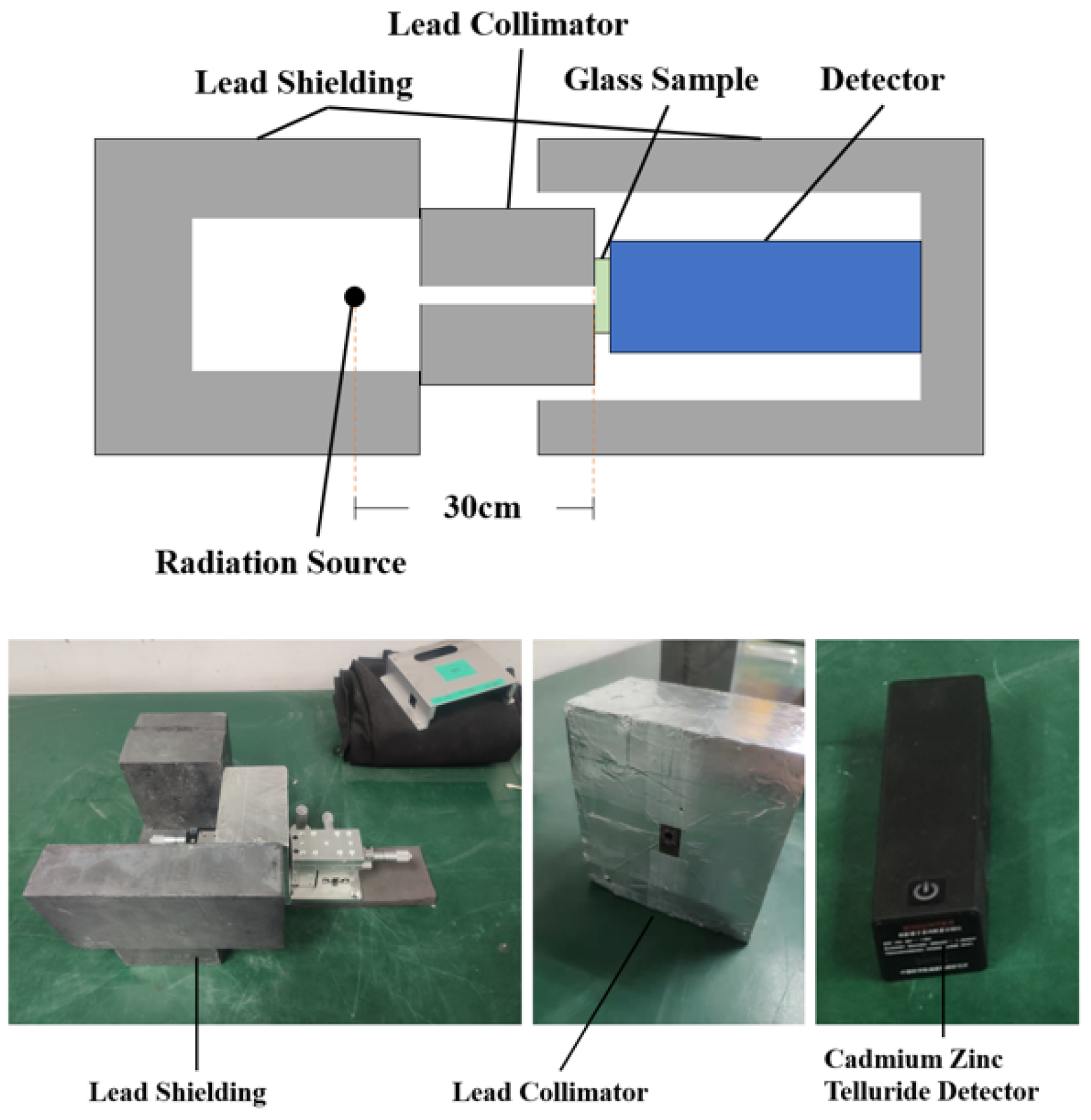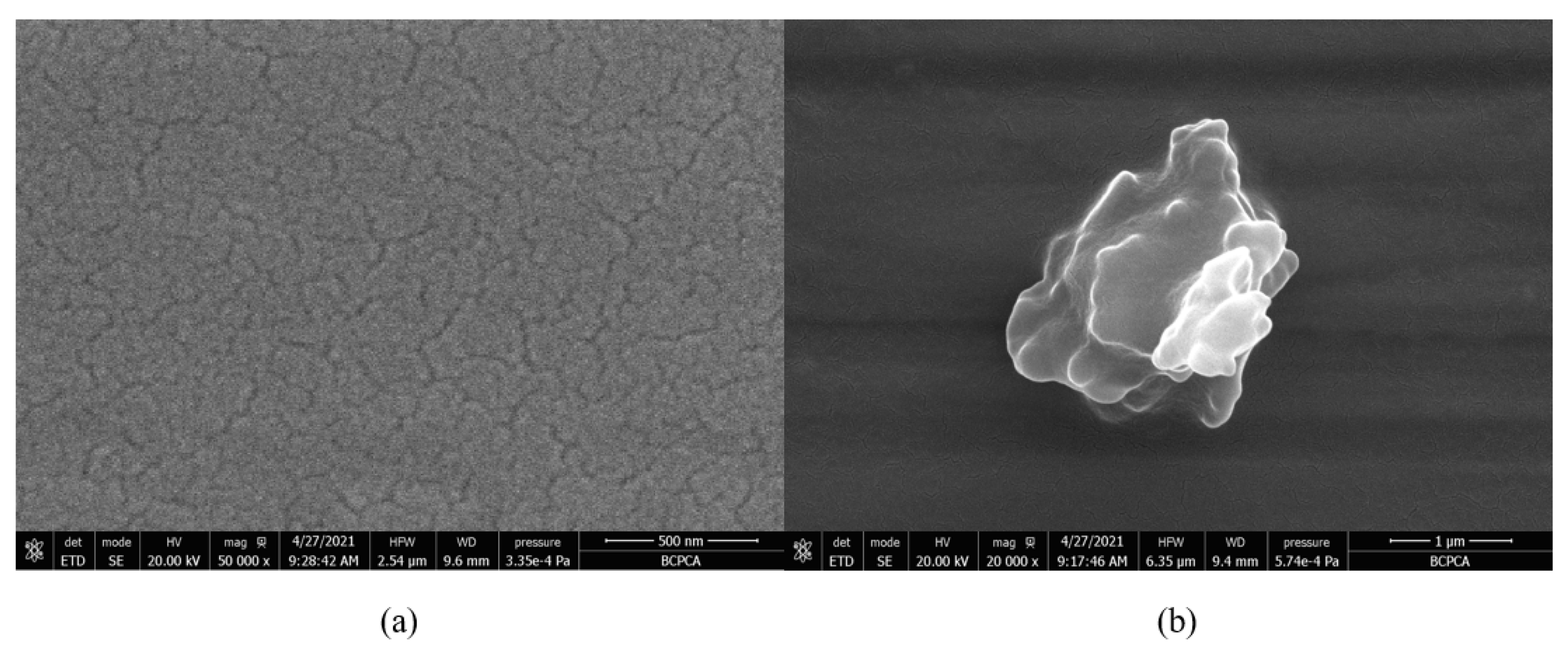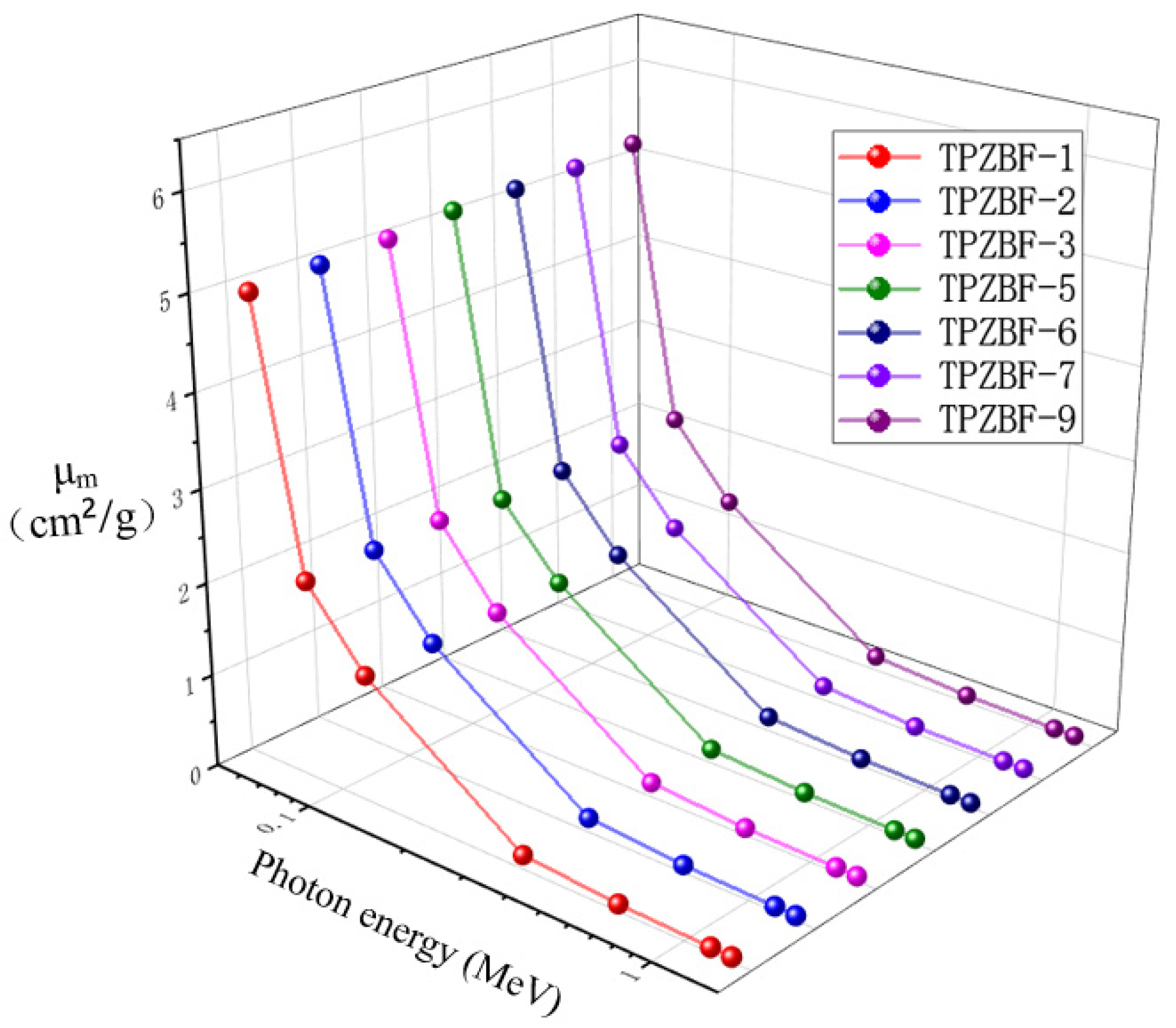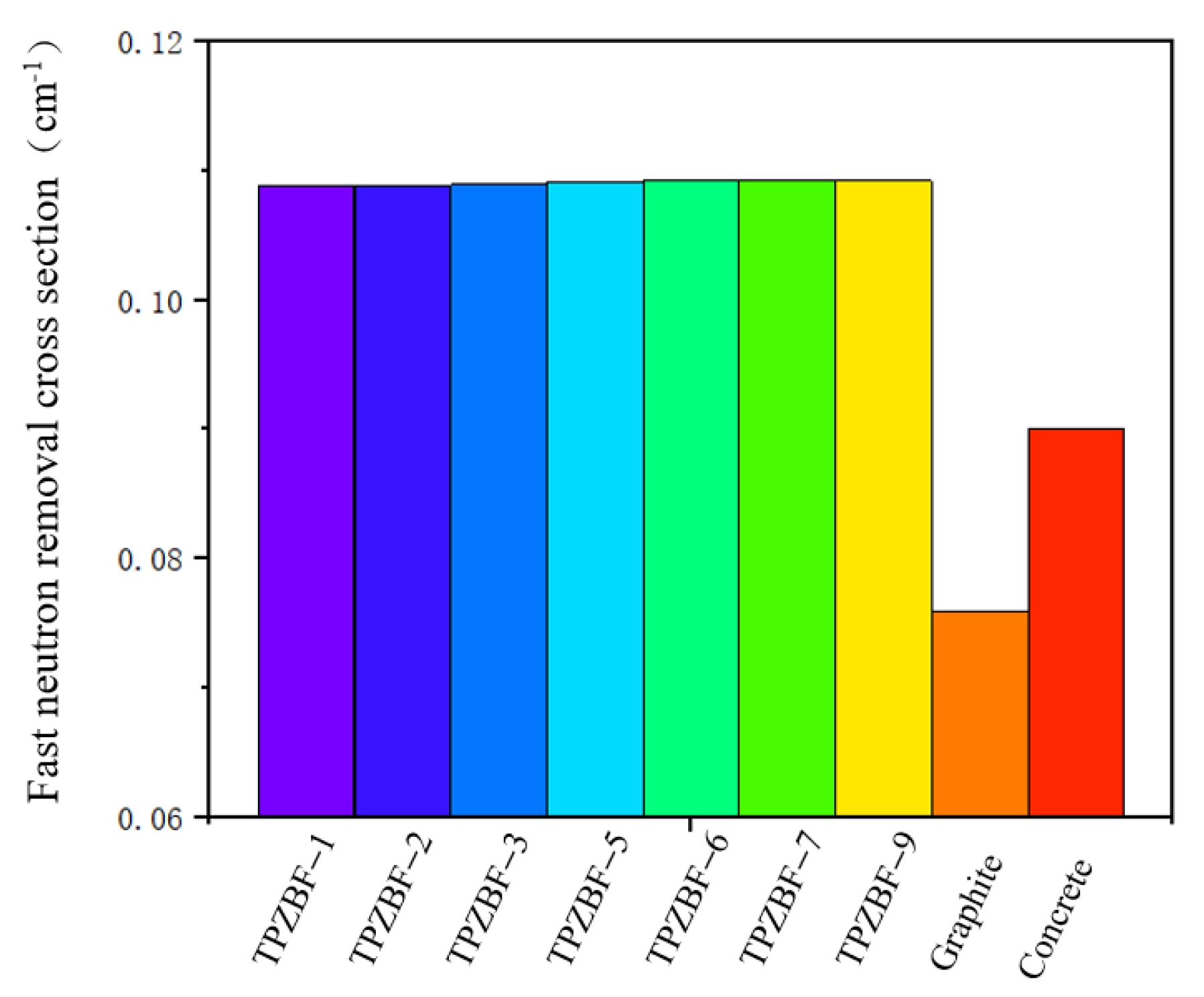Study on Radiation Shielding Properties of New Barium-Doped Zinc Tellurite Glass
Abstract
:1. Introduction
2. Materials and Methods
2.1. Sample Preparation
2.2. Radiation Shielding Experiment
2.3. Other Physical Stability Experiments
3. Theory
4. Results and Discussion
5. Conclusions
Author Contributions
Funding
Institutional Review Board Statement
Informed Consent Statement
Data Availability Statement
Conflicts of Interest
References
- Yasmin, S.; Barua, B.S.; Khandaker, M.U.; Chowdhury, F.-U.; Rashid, A.; Bradley, D.A.; Olatunji, M.A.; Kamal, M. Studies of ionizing radiation shielding effectiveness of silica-based commercial glasses used in Bangladeshi dwellings. Results Phys. 2018, 9, 541–549. [Google Scholar] [CrossRef]
- Kaur, P.; Singh, K.; Thakur, S.; Singh, P.; Bajwa, B.J.S. Investigation of bismuth borate glass system modified with barium for structural and gamma-ray shielding properties. Spectrochim. Acta Part A Mol. Biomol. Spectrosc. 2018, 206, 367–377. [Google Scholar] [CrossRef] [PubMed]
- Rammah, Y.; El-Agawany, F.; Abu El Soad, A.; Yousef, E.S.S.; El-Mesady, I. Ionizing radiation attenuation competences of gallium germanate-tellurite glasses utilizing MCNP5 simulation code and Phy-X/PSD program. Ceram. Int. 2020, 46, 22766–22773. [Google Scholar] [CrossRef]
- Tapio, S.; Little, M.P.; Kaiser, J.C.; Impens, N.; Hamada, N.; Georgakilas, A.G.; Simar, D.; Salomaa, S. Ionizing radiation-induced circulatory and metabolic diseases. Environ. Int. 2020, 146, 106235. [Google Scholar] [CrossRef] [PubMed]
- Abouhaswa, A.; Kavaz, E. Bi2O3 effect on physical, optical, structural and radiation safety characteristics of B2O3-Na2O-ZnO -CaO glass system. J. Non-Cryst. Solids 2020, 535, 119993. [Google Scholar] [CrossRef]
- Rajesh, M.; Kavaz, E. Photoluminescence, radiative shielding properties of Sm3+ ions doped fluoroborosilicate glasses for visible (reddish-orange) display and radiation shielding applications. Mater. Res. Bull. 2021, 142, 111383. [Google Scholar] [CrossRef]
- Al-Hadeethi, Y.; Sayyed, M. Analysis of borosilicate glasses doped with heavy metal oxides for gamma radiation shielding application using Geant4 simulation code. Ceram. Int. 2019, 45, 24858–24864. [Google Scholar] [CrossRef]
- Hamad, R.; Mhareb, M.; Alajerami, Y.; Sayyed, M.; Saleh, G.; Hamad, M.K.; Ziq, K. A comprehensive ionizing radiation shielding study of FexSe0.5Te0.5 alloys with various iron concentrations. J. Alloys Compd. 2020, 858, 157636. [Google Scholar] [CrossRef]
- Almisned, G.; Tekin, H.O.; Ene, A.; Issa, S.A.M.; Kilic, G.; Zakaly, H.M.H. A Closer Look on Nuclear Radiation Shielding Properties of Eu3+ Doped Heavy Metal Oxide Glasses: Impact of Al2O3/PbO Substitution. Materials 2021, 14, 5334. [Google Scholar] [CrossRef] [PubMed]
- Al-Buriahi, M.; Sayyed, M.; Al-Hadeethi, Y. Role of TeO2 in radiation shielding characteristics of calcium boro-tellurite glasses. Ceram. Int. 2020, 46, 13622–13629. [Google Scholar] [CrossRef]
- Olarinoye, I.; Alomairy, S.; Sriwunkum, C.; Al-Buriahi, M.S. Effect of Ag2O/V2O5 substitution on the radiation shielding ability of tellurite glass system via XCOM approach and FLUKA simulations. Phys. Scr. 2021, 96, 065308. [Google Scholar] [CrossRef]
- Yin, S.; Wang, H.; Wang, S.; Zhang, J.; Zhu, Y. Effect of B2O3 on the Radiation Shielding Performance of Telluride Lead Glass System. Crystals 2022, 12, 178. [Google Scholar] [CrossRef]
- Al-Buriahi, M.S.; Hegazy, H.H.; Alresheedi, F.; Somaily, H.H.; Sriwunkum, C.; Olarinoye, I.O. Effect of Sb2O3 addition on radiation attenuation properties of tellurite glasses containing V2O5 and Nb2O5. Appl. Phys. A 2021, 127, 106. [Google Scholar] [CrossRef]
- Halimah, M.; Azuraida, A.; Ishak, M.; Hasnimulyati, L. Influence of bismuth oxide on gamma radiation shielding properties of boro-tellurite glass. J. Non-Cryst. Solids 2019, 512, 140–147. [Google Scholar] [CrossRef]
- AlBuriahi, M.; Hegazy, H.; Alresheedi, F.; Olarinoye, I.; Algarni, H.; Tekin, H.; Saudi, H. Effect of CdO addition on photon, electron, and neutron attenuation properties of boro-tellurite glasses. Ceram. Int. 2020, 47, 5951–5958. [Google Scholar] [CrossRef]
- Al-Buriahi, M.; Bakhsh, E.M.; Tonguc, B.; Khan, S.B. Mechanical and radiation shielding properties of tellurite glasses doped with ZnO and NiO. Ceram. Int. 2020, 46, 19078–19083. [Google Scholar] [CrossRef]
- Yin, S.; Wang, H.; Li, A.; Huang, H.; Zhang, J.; Liu, L.; Zhu, Y. Study on the Optical Properties of High Refractive Index TeO2-PbO-ZnO-BaF2 Glass System. Adv. Mater. Sci. Eng. 2021, 2021, 6466344. [Google Scholar] [CrossRef]
- Hegazy, H.H.; Al-Buriahi, M.S.; Alresheedi, F.; Alraddadi, S.; Arslan, H.; Algarni, H. The Effects of TeO2 on Polarizability, Optical Transmission, and Photon/Neutron Attenuation Properties of Boro-Zinc-Tellurite Glasses. J. Inorg. Organomet. Polym. Mater. 2021, 31, 2331–2338. [Google Scholar] [CrossRef]
- Hanfi, M.; Sayyed, M.; Lacomme, E.; Akkurt, I.; Mahmoud, K. The influence of MgO on the radiation protection and mechanical properties of tellurite glasses. Nucl. Eng. Technol. 2020, 53, 2000–2010. [Google Scholar] [CrossRef]
- Sayyed, M.I.; Issa, S.A.; Büyükyıldız, M.; Dong, M. Determination of nuclear radiation shielding properties of some tellurite glasses using MCNP5 code. Radiat. Phys. Chem. 2018, 150, 1–8. [Google Scholar] [CrossRef]
- Kurtulus, R.; Kurtulus, C.; Kavas, T. Nuclear radiation shielding characteristics and physical, optical, mechanical, and thermal properties of lithium-borotellurite glass doped with Rb2O. Prog. Nucl. Energy. 2021, 141, 103961. [Google Scholar] [CrossRef]
- Al-Hadeethi, Y.; Sayyed, M. The influence of PbO on the radiation attenuation features of tellurite glass. Ceram. Int. 2019, 45, 24230–24235. [Google Scholar] [CrossRef]
- Zaid, M.; Matori, K.; Sidek, H.; Ibrahim, I. Bismuth modified gamma radiation shielding properties of titanium vanadium sodium tellurite glasses as a potent transparent radiation-resistant glass applications. Nucl. Eng. Technol. 2020, 53, 1323–1330. [Google Scholar] [CrossRef]
- Manohara, S.; Hanagodimath, S.; Thind, K.; Gerward, L. On the effective atomic number and electron density: A comprehensive set of formulas for all types of materials and energies above 1keV. Nucl. Instrum. Methods Phys. Res. Sect. B Beam Interact. Mater. At. 2008, 266, 3906–3912. [Google Scholar] [CrossRef]
- Wood, J. Computational Methods in Reactor Shielding; Pergamon Press: New York, NY, USA, 1982. [Google Scholar] [CrossRef]
- Chilton, A.B.; Shultis, J.K.; Faw, R.E. Principles of Radiation Shielding, Prentice-Hall; Prentice Hall: Englewood Cliffs, NJ, USA, 1984. [Google Scholar]








| Sample Code | Chemical Composition | Density | Mass Fraction | ||||||||
|---|---|---|---|---|---|---|---|---|---|---|---|
| TeO2 | PbO | ZnO | BaF2 | /(g·cm−3) | O | F | Zn | Te | Ba | Pb | |
| TPZBF1 | 60 | 20 | 19 | 1 | 6.243 | 0.16141 | 0.00241 | 0.07881 | 0.48574 | 0.00871 | 0.26292 |
| TPZBF2 | 60 | 20 | 18 | 2 | 6.255 | 0.15944 | 0.00479 | 0.07422 | 0.48286 | 0.01732 | 0.26136 |
| TPZBF3 | 60 | 20 | 17 | 3 | 6.267 | 0.15750 | 0.00715 | 0.06969 | 0.48002 | 0.02583 | 0.25982 |
| TPZBF5 | 60 | 20 | 15 | 5 | 6.295 | 0.15368 | 0.01177 | 0.06077 | 0.47443 | 0.04255 | 0.25680 |
| TPZBF6 | 60 | 20 | 14 | 6 | 6.306 | 0.15181 | 0.01405 | 0.05639 | 0.47168 | 0.05077 | 0.25531 |
| TPZBF7 | 60 | 20 | 13 | 7 | 6.313 | 0.14995 | 0.01629 | 0.05206 | 0.46897 | 0.05889 | 0.25384 |
| TPZBF9 | 60 | 20 | 11 | 9 | 6.327 | 0.14631 | 0.02071 | 0.04355 | 0.46363 | 0.07485 | 0.25095 |
| Energy (MeV) | TPZBF-1 | TPZBF-2 | TPZBF-3 | TPZBF-5 | TPZBF-6 | TPZBF-7 | TPZBF-9 | |
|---|---|---|---|---|---|---|---|---|
| Exp | 4.9637 | 5.0006 | 5.0375 | 5.1100 | 5.1263 | 5.1482 | 5.2108 | |
| 0.059 | XCOM | 4.9410 | 4.9790 | 5.0170 | 5.0920 | 5.1290 | 5.1650 | 5.2370 |
| Dev | 0.46% | 0.43% | 0.41% | 0.35% | 0.05% | 0.33% | 0.50% | |
| Exp | 2.1350 | 2.1532 | 2.1703 | 2.1045 | 2.1359 | 2.1532 | 2.1703 | |
| 0.081 | XCOM | 2.1120 | 2.1280 | 2.1450 | 2.1760 | 2.1920 | 2.2080 | 2.2380 |
| Dev | 1.09% | 1.18% | 1.18% | 3.29% | 2.56% | 2.48% | 3.03% | |
| Exp | 1.3655 | 1.3712 | 1.3783 | 1.3846 | 1.3855 | 1.3912 | 1.3983 | |
| 0.122 | XCOM | 1.3920 | 1.3930 | 1.3950 | 1.3970 | 1.3980 | 1.4000 | 1.4020 |
| Dev | 1.90% | 1.56% | 1.20% | 1.23% | 0.89% | 0.63% | 0.26% | |
| Exp | 0.1506 | 0.1533 | 0.1551 | 0.1542 | 0.1556 | 0.1563 | 0.1571 | |
| 0.356 | XCOM | 0.1549 | 0.1549 | 0.1549 | 0.1549 | 0.1550 | 0.1550 | 0.1550 |
| Dev | 2.78% | 1.03% | 0.13% | 0.45% | 0.39% | 0.84% | 1.35% | |
| Exp | 0.0785 | 0.0785 | 0.0785 | 0.0785 | 0.0785 | 0.0786 | 0.0786 | |
| 0.662 | XCOM | 0.0806 | 0.0807 | 0.0807 | 0.0808 | 0.0809 | 0.0809 | 0.0809 |
| Dev | 2.61% | 2.73% | 2.70% | 2.80% | 2.94% | 2.88% | 2.87% | |
| Exp | 0.0546 | 0.0547 | 0.0547 | 0.0547 | 0.0546 | 0.0547 | 0.0547 | |
| 1.173 | XCOM | 0.0544 | 0.0544 | 0.0544 | 0.0545 | 0.0545 | 0.0545 | 0.0546 |
| Dev | 0.46% | 0.55% | 0.50% | 0.46% | 0.17% | 0.29% | 0.26% | |
| Exp | 0.0512 | 0.0512 | 0.0513 | 0.0513 | 0.0512 | 0.0512 | 0.0513 | |
| 1.332 | XCOM | 0.0505 | 0.0506 | 0.0506 | 0.0506 | 0.0507 | 0.0507 | 0.0507 |
| Dev | 1.35% | 1.25% | 1.40% | 1.34% | 1.05% | 1.01% | 1.14% | |
| Ep (MeV) | 0.2 | 0.3 | 0.4 | 0.5 | 0.6 | 0.8 | 1 | 1.5 | 2 |
|---|---|---|---|---|---|---|---|---|---|
| Ba | 0.4045 | 0.1891 | 0.1265 | 0.0992 | 0.0841 | 0.0674 | 0.0580 | 0.0459 | 0.0407 |
| Pb | 0.9985 | 0.4026 | 0.2323 | 0.1613 | 0.1248 | 0.0887 | 0.0710 | 0.0522 | 0.0460 |
| Ba/Pb | 2.468 | 2.212 | 1.836 | 1.625 | 1.483 | 1.315 | 1.224 | 1.137 | 1.129 |
Publisher’s Note: MDPI stays neutral with regard to jurisdictional claims in published maps and institutional affiliations. |
© 2022 by the authors. Licensee MDPI, Basel, Switzerland. This article is an open access article distributed under the terms and conditions of the Creative Commons Attribution (CC BY) license (https://creativecommons.org/licenses/by/4.0/).
Share and Cite
Yin, S.; Wang, H.; Li, A.; Ma, Z.; He, Y. Study on Radiation Shielding Properties of New Barium-Doped Zinc Tellurite Glass. Materials 2022, 15, 2117. https://doi.org/10.3390/ma15062117
Yin S, Wang H, Li A, Ma Z, He Y. Study on Radiation Shielding Properties of New Barium-Doped Zinc Tellurite Glass. Materials. 2022; 15(6):2117. https://doi.org/10.3390/ma15062117
Chicago/Turabian StyleYin, Shiyu, Hao Wang, Aifeng Li, Zhongjian Ma, and Yintong He. 2022. "Study on Radiation Shielding Properties of New Barium-Doped Zinc Tellurite Glass" Materials 15, no. 6: 2117. https://doi.org/10.3390/ma15062117
APA StyleYin, S., Wang, H., Li, A., Ma, Z., & He, Y. (2022). Study on Radiation Shielding Properties of New Barium-Doped Zinc Tellurite Glass. Materials, 15(6), 2117. https://doi.org/10.3390/ma15062117






